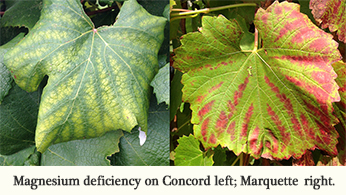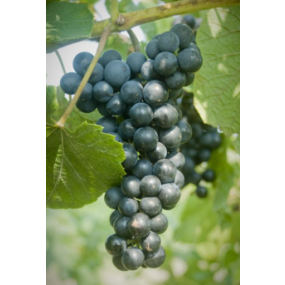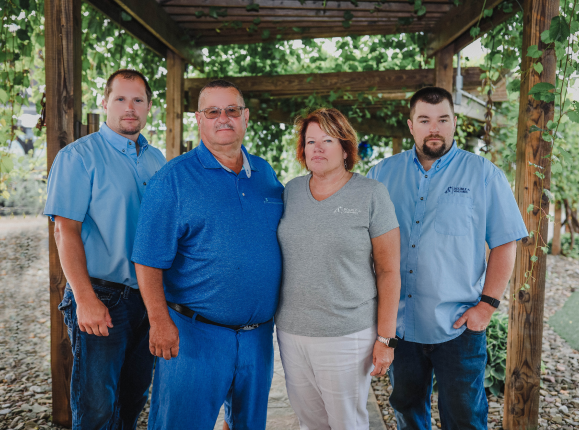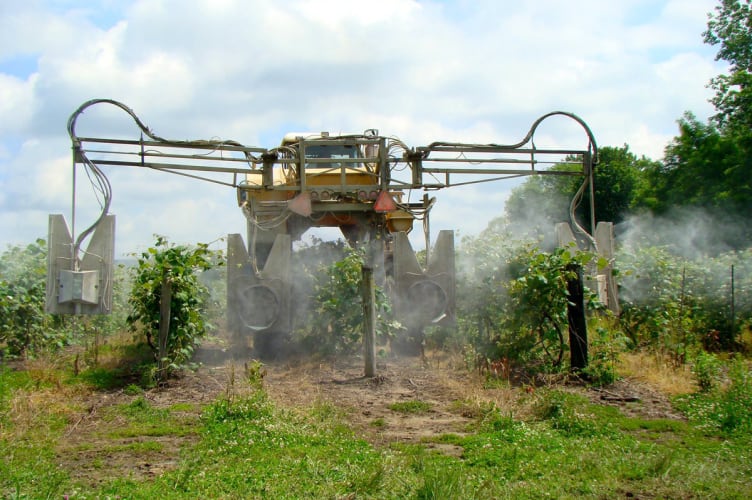Vineyard Fertilizer and Nutrient Recommendations Provided by Double A Vineyards

Rick Dunst, Viticulturist, Double A Vineyards, Inc.
Most grape growers recognize the need to determine the nutritional status of their soil prior to planting, but it is also important to monitor the nutritional status of the vineyard on a regular basis once it is bearing fruit. Ideally, soil and petiole testing are used together to monitor the nutritional status of the vineyard in order to anticipate deficiencies and correct them before they affect vine growth, fruit set, and fruit and wine quality, but testing is also often used to confirm deficiencies suspected after the development of symptoms on leaves or fruit clusters. Soil and petiole tests should be taken every three years or so in order to gauge vineyard nutrient levels to optimize vineyard nutrient status or to correct deficiencies with appropriate supplemental fertilizer applications.
Double A Vineyards offers nutrient analysis through a reputable laboratory and provides interpretation and recommendations appropriate for native, hybrid, and vinifera vineyards. You can order your nutrient testing package here:
Plant Nutrient Analyses- Petiole Package
Soil and Plant Nutrient Analyses Combo Package
Once you receive your sample kit, collect and dry the sample and mail it to the lab. Results are sent to our viticulturist who will forward them to you along with recommendations appropriate to the cultivar being grown.
Soil tests can be collected any time of the year it is convenient, but researchers have identified two optimal growth stages for collecting and analyzing petiole samples to monitor vine nutrient status: during bloom, and in the period between veraison (initial fruit softening and/or coloring at approximately 7° brix) and harvest. Bloom petiole sampling is preferable if poor fruit set has been a problem, especially in identifying micronutrient deficiencies involving boron and zinc. Many growers find themselves overwhelmed with vineyard tasks during bloom, and petiole samples taken after veraison but before harvest can be useful to determine the status of most nutrient levels in the vineyard. Deficiencies of key nutrients such as potassium and magnesium are readily identified from grapevine petiole samples taken either at bloom or after veraison and can be used to adjust fertilization practices prior to the next growing season.
How to Collect Samples
As mentioned, soil samples can be collected any time of the year, but it is most useful for the person making the interpretations to have access to both soil and petiole data. Collect soil from several locations in a vineyard block with uniform soil. If there is more than one soil type in a vineyard block, sample each soil type separately so they can be treated differently, if necessary. Each sample should consist of at least 15 sub samples to a depth of 8”. A soil core sampler or small auger (ca. 1” diameter) can be used. Air dry the sample, mix it up, fill the sample bag provided with the kit, and mail to the lab for analysis.
Petiole samples can be collected from bearing vines at either bloom, or between veraison and harvest. The petiole is the leaf stem between the green shoot and the leaf blade. Samples should be collected from fruit-bearing shoots and should consist of 60-100 petioles. If you collect samples during bloom, collect them from the fruiting zone (leaves opposite blooming clusters). If you collect samples prior to harvest, collect the petioles from the most recently matured leaf (RML) on fruit-bearing shoots. Start at the shoot tip and work back to the first full-sized leaf which is the RML, usually about five to seven leaves back from the shoot tip. On some varieties (like Concord), this is the uppermost leaf on the shoot that shows some browning on the bottom side of the leaf. On VSP-trained vines with summer shoot hedging, sample from the upper part of the canopy a few leaves below where the shoot has been tipped. Once you collect the petioles, wash them in a solution of a drop of dish detergent per gallon or more of water, triple rinse with clean water, air-dry, and send to the lab for analysis. Sample each variety/rootstock combination separately, and take separate samples from areas of the vineyard that appear to have nutrition-related problems such as weak growth, poor fruit set, or leaf deficiency symptoms.















For some reason my rhubarb plants I purchased from you this spring did not, with the exception of one, even started to leaf out. The one that leafed out just died all of a sudden. They were planted in tubs with nursery potting soil. they were not exposed to the hot sun but started in the shade. So, since this is a warmer climate, is it possible to get replacements before next spring?
I’m interested in the petiole analysis. But now about two weeks ago I picked most of my whites (Chardonnel, Voignier, Chardonnay, and some Vidal). Yesterday, I picked the rest of the Vidal, and Cab Franc, leaving Cab Sauv for later. Is it worthwhile now to submit the other white variety petioles? I harvested the petioles on the ones picked yesterday today (9/11/16). Would the results be valid to submit petioles taken from the two varieties I picked yesterday? I’m on the Northern Neck of Va. Please advise.